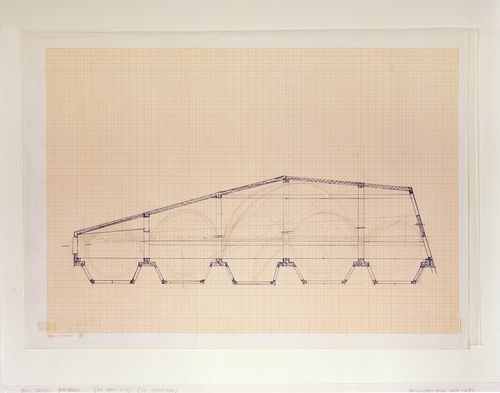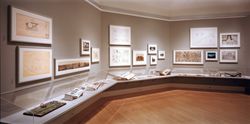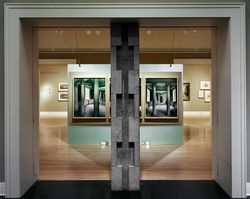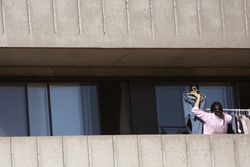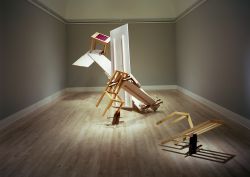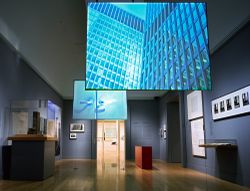PH2018:0005:033
Description:
Photograph by Stefano Graziani of the following work: Gordon Matta-Clark, floor plan for Office Baroque, 1977, blue ballpoint pen on graph paper, 42 x 59.5 cm, PHCON2002:0016:058, Gordon Matta-Clark collection, Canadian Centre of Architecture, Gift of Estate of Gordon Matta-Clark, © Estate of Gordon Matta-Clark Questioning Pictures is a 36 photograph project commissioned by Fondazione Prada, Milan. Artist Stefano Graziani investigates archival and conservation systems in a number of museums. Through photographing museum objects, Graziani, focusing on the relationship between photographs, the museum objects and the power structures at play within institutions. The museums include the Canadian Centre for Architecture (CCA) in Montréal, Canada; Sir John Soane’s Museum in London, UK; the Kunstmuseum Basel, Switzerland; Museum Insel Hombroich in Neuss, Germany; the Museo di Castelvecchio in Verona, Italy; and the Plaster Cast Gallery at Museo Canova in Possagno, Italy.
2017
Questioning Pictures: Photograph of floor plan for office Baroque, blue pen on graph paper by Gordon Matta-Clark, 1977
Actions:
PH2018:0005:033
Description:
Photograph by Stefano Graziani of the following work: Gordon Matta-Clark, floor plan for Office Baroque, 1977, blue ballpoint pen on graph paper, 42 x 59.5 cm, PHCON2002:0016:058, Gordon Matta-Clark collection, Canadian Centre of Architecture, Gift of Estate of Gordon Matta-Clark, © Estate of Gordon Matta-Clark Questioning Pictures is a 36 photograph project commissioned by Fondazione Prada, Milan. Artist Stefano Graziani investigates archival and conservation systems in a number of museums. Through photographing museum objects, Graziani, focusing on the relationship between photographs, the museum objects and the power structures at play within institutions. The museums include the Canadian Centre for Architecture (CCA) in Montréal, Canada; Sir John Soane’s Museum in London, UK; the Kunstmuseum Basel, Switzerland; Museum Insel Hombroich in Neuss, Germany; the Museo di Castelvecchio in Verona, Italy; and the Plaster Cast Gallery at Museo Canova in Possagno, Italy.
Cedric Price : de tout temps
L’architecte britannique Cedric Price s’est servi de la collection du CCA pour établir des rapports complexes entre temps, espace et mouvement dans l’environnement bâti. Analysant des structures et des bâtiments de différentes époques, dont certains projets de Price lui-même, De tout temps présente des photographies d’un calendrier solaire aztèque, d’une gare de triage,(...)
Salle octogonale
19 octobre 1999 au 27 février 2000
Cedric Price : de tout temps
Actions:
Description:
L’architecte britannique Cedric Price s’est servi de la collection du CCA pour établir des rapports complexes entre temps, espace et mouvement dans l’environnement bâti. Analysant des structures et des bâtiments de différentes époques, dont certains projets de Price lui-même, De tout temps présente des photographies d’un calendrier solaire aztèque, d’une gare de triage,(...)
Salle octogonale
Tout comme la villa Rotonda d’Andrea Palladio a contribué à définir, pour les générations suivantes, l’architecture de la Renaissance en Italie, Chiswick est le locus classicus du renouveau palladien au XVIIIe siècle. L’exposition suit le déroulement de la pensée d’un grand architecte qui transforme successivement ses sources d’inspiration en projet architectural, puis(...)
Salles principales
19 juillet 1994 au 25 septembre 1994
Le renouveau palladien : la villa et les jardins de Lord Burlington à Chiswick
Actions:
Description:
Tout comme la villa Rotonda d’Andrea Palladio a contribué à définir, pour les générations suivantes, l’architecture de la Renaissance en Italie, Chiswick est le locus classicus du renouveau palladien au XVIIIe siècle. L’exposition suit le déroulement de la pensée d’un grand architecte qui transforme successivement ses sources d’inspiration en projet architectural, puis(...)
Salles principales
Un atlas, un bricolage, une collection de stratégies et d’interventions variés permettant de comprendre Montréal. ABC : MTL est un abécédaire urbain et une plateforme ouverte cartographiant la ville contemporaine de façons multiples et au travers de différentes techniques. Plus de 90 contributions comprenant des photographies, des vidéoclips, des sculptures, des(...)
Salles principales
13 novembre 2012 au 31 mars 2013
ABC : MTL – Un autoportrait de Montréal
Actions:
Description:
Un atlas, un bricolage, une collection de stratégies et d’interventions variés permettant de comprendre Montréal. ABC : MTL est un abécédaire urbain et une plateforme ouverte cartographiant la ville contemporaine de façons multiples et au travers de différentes techniques. Plus de 90 contributions comprenant des photographies, des vidéoclips, des sculptures, des(...)
Salles principales
Paraboles et autres allégories : L’Œuvre de Melvin Charney 1975-1990 présente une centaine de dessins, dont plusieurs à grande échelle, des esquisses, des photographies, ainsi que trois grandes constructions. Réunissant des pièces issues de diverses collections publiques et privées, dont celle du CCA, l’exposition permet une analyse globale de la démarche artistique de(...)
Salles principales
9 octobre 1991 au 12 janvier 1992
Paraboles et autres allégories : L'oeuvre de Melvin Charney, 1975-1990
Actions:
Description:
Paraboles et autres allégories : L’Œuvre de Melvin Charney 1975-1990 présente une centaine de dessins, dont plusieurs à grande échelle, des esquisses, des photographies, ainsi que trois grandes constructions. Réunissant des pièces issues de diverses collections publiques et privées, dont celle du CCA, l’exposition permet une analyse globale de la démarche artistique de(...)
Salles principales
Mies en Amérique
Grand penseur et artiste minutieux, et l’un des plus illustres architectes de l’histoire, Ludwig Mies van der Rohe est déjà une figure dominante de sa profession en Allemagne, lorsque, en 1938, dans la cinquantaine, il émigre aux États-Unis. Transplanté de l’école du Bauhaus (dont il a été le dernier directeur) à un institut technique de Chicago, délaissant le milieu de(...)
Salles principales
17 octobre 2001 au 20 janvier 2002
Mies en Amérique
Actions:
Description:
Grand penseur et artiste minutieux, et l’un des plus illustres architectes de l’histoire, Ludwig Mies van der Rohe est déjà une figure dominante de sa profession en Allemagne, lorsque, en 1938, dans la cinquantaine, il émigre aux États-Unis. Transplanté de l’école du Bauhaus (dont il a été le dernier directeur) à un institut technique de Chicago, délaissant le milieu de(...)
Salles principales
Views of Japan
PH1983:0516:001-051
Description:
Felice Beato was one of the first photographers to systematically survey Japan in his 'Photographic Views of Japan with Historical and Descriptive Notes' (1869), containing about one hundred landscapes. This present album does not have a title page but some of the photographs are also found in 'Views of Japan' and another Beato album from the CCA's collection (PH1981:0787:001-093). This present album shows 51 views of Japan in several villages, towns, places and countryside, such as Yokohama, the Tokaido link, Mayonashi, Hakoni, Fusi-Yama, Miyanoshita, Sakawa Nagawa, Gakaiso, Nagasaki, Eiyama, Harra, Omia, Narraiga, Miyanoshita, Tonosawa, Kamakura, Taikeins and Pappenburg. Also shown are peasants, girls, sumotori (wrestlers), northeners, officers, a musician, a doctor and patient, an executioner, firemen, a painter and a priest, etc. Captions with detailed annotations written by Beato's colleagues are pasted on to the facing pages. The photographer Baron Raimund Stillfried who also worked in Japan, acquired the stock and studio of Beato in 1877. A mixture of his own and Beato's work is contained in his subsequent albums, which makes it sometimes difficult to differentiate between a Beato and a Stillfried photograph (cf. Terry Bennett).
architecture
ca. 1869
Views of Japan
Actions:
PH1983:0516:001-051
Description:
Felice Beato was one of the first photographers to systematically survey Japan in his 'Photographic Views of Japan with Historical and Descriptive Notes' (1869), containing about one hundred landscapes. This present album does not have a title page but some of the photographs are also found in 'Views of Japan' and another Beato album from the CCA's collection (PH1981:0787:001-093). This present album shows 51 views of Japan in several villages, towns, places and countryside, such as Yokohama, the Tokaido link, Mayonashi, Hakoni, Fusi-Yama, Miyanoshita, Sakawa Nagawa, Gakaiso, Nagasaki, Eiyama, Harra, Omia, Narraiga, Miyanoshita, Tonosawa, Kamakura, Taikeins and Pappenburg. Also shown are peasants, girls, sumotori (wrestlers), northeners, officers, a musician, a doctor and patient, an executioner, firemen, a painter and a priest, etc. Captions with detailed annotations written by Beato's colleagues are pasted on to the facing pages. The photographer Baron Raimund Stillfried who also worked in Japan, acquired the stock and studio of Beato in 1877. A mixture of his own and Beato's work is contained in his subsequent albums, which makes it sometimes difficult to differentiate between a Beato and a Stillfried photograph (cf. Terry Bennett).
ca. 1869
architecture
Série(s)
CD041.S5
Description:
This series documents nine projects by the firm Vecsei Architects. In 1984, Eva Hollo Vecsei and André Vecsei opened a joint practice, Vecsei Architects. Both architects retired in 2005. Together they worked on several major planning studies, such as Les Hautières du Mont-Royal, Montréal, Québec (circa 1983-1988) and the Genome Centre and the Lorne M. Trottier Building, Montréal (1999-2000), documented in this series. Les Hautières du Mont-Royal was a residential complex adjacent to Montréal's Golden Square Mile, on Cedar Avenue. The project consisted of nine staggering buildings (29 villas) around a landscaped European-style courtyard on a sloping site facing Mount Royal while also preserving a turn of the century landmark situated within the Mount Royal Heritage Site . The project is also known as "Projet Cours Cedar". Through the Genome Centre, McGill University sought to fill a need for a modern and cross-disciplinary research space in genomics and proteomics. Vecsei Architects submitted a joint proposal with Dupuis, Le Tourneaux, architects, and NFOE et associés architectes. Ultimately, KPMB Architects and Fichten Soiferman et Associés, Architectes' proposal was chosen and built. The Lorne M. Trottier Building is a building for popular electrical engineering, computer science and telecommunications programs at McGill University. Vecsei Architects submitted a joint proposal for this project with Julian Jacobs Architectes and Architectes Lemay et associés. Jodoin Lamarre Pratte architectes and Marosi Troy's proposal was chosen and built. Also documented in this series are the following projects: Elementary school for College Marie de France, Montréal, Québec (circa 1984-1986); High-rise office tower, underground commercial centre tied to Montréal’s underground mall and subway network, Christ Church Cathedral, Montréal, Québec (circa 1987-1988); Seniors condominium, Manoir Montefiore, Côte-Saint-Luc, Québec (1988); Ark and artworks for the Beth Zion Synagogue, Côte-Saint-Luc, Québec (1989); Municipal library, Dollard-des-Ormeaux, Québec (circa 1990), Cultural Centre and extension of sport centre, Dollard-des-Ormeaux, Québec (circa 2001-2003); Renovation and new elevation for Schneider house, Montréal, Québec (2002). Collection material in this series was produced between 1983 and 2006. Documents include architectural records, such as presentation, conceptual, and design development drawings, and as well as photographs of facades and interior views. This series also includes digital material (mainly photographs), and a few project proposals and publications. The level of documentation varies greatly from project to project, from a single presentation drawing to complete project proposal.
1983-2006
Vecsei Architects (1984-2005)
Actions:
CD041.S5
Description:
This series documents nine projects by the firm Vecsei Architects. In 1984, Eva Hollo Vecsei and André Vecsei opened a joint practice, Vecsei Architects. Both architects retired in 2005. Together they worked on several major planning studies, such as Les Hautières du Mont-Royal, Montréal, Québec (circa 1983-1988) and the Genome Centre and the Lorne M. Trottier Building, Montréal (1999-2000), documented in this series. Les Hautières du Mont-Royal was a residential complex adjacent to Montréal's Golden Square Mile, on Cedar Avenue. The project consisted of nine staggering buildings (29 villas) around a landscaped European-style courtyard on a sloping site facing Mount Royal while also preserving a turn of the century landmark situated within the Mount Royal Heritage Site . The project is also known as "Projet Cours Cedar". Through the Genome Centre, McGill University sought to fill a need for a modern and cross-disciplinary research space in genomics and proteomics. Vecsei Architects submitted a joint proposal with Dupuis, Le Tourneaux, architects, and NFOE et associés architectes. Ultimately, KPMB Architects and Fichten Soiferman et Associés, Architectes' proposal was chosen and built. The Lorne M. Trottier Building is a building for popular electrical engineering, computer science and telecommunications programs at McGill University. Vecsei Architects submitted a joint proposal for this project with Julian Jacobs Architectes and Architectes Lemay et associés. Jodoin Lamarre Pratte architectes and Marosi Troy's proposal was chosen and built. Also documented in this series are the following projects: Elementary school for College Marie de France, Montréal, Québec (circa 1984-1986); High-rise office tower, underground commercial centre tied to Montréal’s underground mall and subway network, Christ Church Cathedral, Montréal, Québec (circa 1987-1988); Seniors condominium, Manoir Montefiore, Côte-Saint-Luc, Québec (1988); Ark and artworks for the Beth Zion Synagogue, Côte-Saint-Luc, Québec (1989); Municipal library, Dollard-des-Ormeaux, Québec (circa 1990), Cultural Centre and extension of sport centre, Dollard-des-Ormeaux, Québec (circa 2001-2003); Renovation and new elevation for Schneider house, Montréal, Québec (2002). Collection material in this series was produced between 1983 and 2006. Documents include architectural records, such as presentation, conceptual, and design development drawings, and as well as photographs of facades and interior views. This series also includes digital material (mainly photographs), and a few project proposals and publications. The level of documentation varies greatly from project to project, from a single presentation drawing to complete project proposal.
Series
1983-2006
La preuve par l’architecture
La preuve par l’architecture présente une collection de pièces rassemblées dans le cadre d’une analyse technico-légale de l’architecture d’Auschwitz. L’exposition réunit des moulages en plâtre de bleus, de lettres, de factures d’entrepreneurs et de photographies, ainsi que deux reconstitutions de monuments (une colonne de gaz et une trappe étanche au gaz), qui, considérés(...)
Salle octogonale
16 juin 2016 au 11 septembre 2016
La preuve par l’architecture
Actions:
Description:
La preuve par l’architecture présente une collection de pièces rassemblées dans le cadre d’une analyse technico-légale de l’architecture d’Auschwitz. L’exposition réunit des moulages en plâtre de bleus, de lettres, de factures d’entrepreneurs et de photographies, ainsi que deux reconstitutions de monuments (une colonne de gaz et une trappe étanche au gaz), qui, considérés(...)
Salle octogonale
Projet
AP018.S1.1969.PR01
Description:
This project series documents the expansion of the Art Gallery of Ontario (AGO) in Toronto from 1969-1974. The office identified the project as number 69006. This project consisted of the vast expansion of the AGO that began in 1969, which largely came about due to a multi-million dollar donation from English sculpture Henry Moore. Most prominent in this project was the design and construction of the Henry Moore Sculpture Centre, a new gallery to house the extensive artworks of Henry Moore in the AGO’s collection. This included $15 million’s worth of art that Moore donated at the start of the project. The project was made up of two phases. The first included construction of the Henry Moore Sculpture Centre, the Sam and Ayala Zacks Wing, a link to the pre-existing Grange mansion, and updates to the art gallery’s finishes. The second phase proposed additional updates to existing finishes. By the end of this project, the architects had also added a public lounge, dining room and cafeteria, a members’ lounge, lecture areas (including the Henry Moore Lecture Hall), classrooms, and spaces for the gallery’s special services. The work was further divided into 4 physical areas of the art gallery (A, B, C and D) and the drawings for this project reflect this division. Before this work had been completed, a “Stage II” to the expansion had already been approved by the owners (Stage II is also included in this fonds, see AP018.S1.1972.PR08). In the documentation, this project was originally called the Henry Moore Sculpture Centre, Art Gallery of Ontario, Expansion Phases 1 and 2. However, as multiple stages to the expansion developed later on, this project eventually became known as the Stage I Expansion. While the project contract was originally given to John B. Parkin Associates, John C. Parkin continued the project under his new firm, Parkin Architects Planners, after parting ways with partner John B. Parkin in 1971. The project is recorded through drawings, textual records, and mounted photographs dating from 1968-1986. There are numerous original drawings showing the design development of the new galleries. Two presentation boards show photographs of the project model. The textual records consist of correspondence with contractors and clients, inspection and other site reports, specifications, contract data, consultancy records, schedules, change orders, financial documentation, conference reports, area calculations, research materials, detail planning records, and project notebooks. Box AP018.S1.1969.PR01.007 contains an index to the textual records, which was created by the office. This project series also contains one box of textual documentation that spans across multiple project series related to the AGO expansion within this fonds (see AP018.S1.1969.PR01.044). This includes press releases, newspaper articles, project proposals and studies, correspondence with Henry Moore, meeting minutes and reports.
1968-1986
Henry Moore Sculpture Centre, Art Gallery of Ontario, Stage I Expansion, Toronto (1969-1974)
Actions:
AP018.S1.1969.PR01
Description:
This project series documents the expansion of the Art Gallery of Ontario (AGO) in Toronto from 1969-1974. The office identified the project as number 69006. This project consisted of the vast expansion of the AGO that began in 1969, which largely came about due to a multi-million dollar donation from English sculpture Henry Moore. Most prominent in this project was the design and construction of the Henry Moore Sculpture Centre, a new gallery to house the extensive artworks of Henry Moore in the AGO’s collection. This included $15 million’s worth of art that Moore donated at the start of the project. The project was made up of two phases. The first included construction of the Henry Moore Sculpture Centre, the Sam and Ayala Zacks Wing, a link to the pre-existing Grange mansion, and updates to the art gallery’s finishes. The second phase proposed additional updates to existing finishes. By the end of this project, the architects had also added a public lounge, dining room and cafeteria, a members’ lounge, lecture areas (including the Henry Moore Lecture Hall), classrooms, and spaces for the gallery’s special services. The work was further divided into 4 physical areas of the art gallery (A, B, C and D) and the drawings for this project reflect this division. Before this work had been completed, a “Stage II” to the expansion had already been approved by the owners (Stage II is also included in this fonds, see AP018.S1.1972.PR08). In the documentation, this project was originally called the Henry Moore Sculpture Centre, Art Gallery of Ontario, Expansion Phases 1 and 2. However, as multiple stages to the expansion developed later on, this project eventually became known as the Stage I Expansion. While the project contract was originally given to John B. Parkin Associates, John C. Parkin continued the project under his new firm, Parkin Architects Planners, after parting ways with partner John B. Parkin in 1971. The project is recorded through drawings, textual records, and mounted photographs dating from 1968-1986. There are numerous original drawings showing the design development of the new galleries. Two presentation boards show photographs of the project model. The textual records consist of correspondence with contractors and clients, inspection and other site reports, specifications, contract data, consultancy records, schedules, change orders, financial documentation, conference reports, area calculations, research materials, detail planning records, and project notebooks. Box AP018.S1.1969.PR01.007 contains an index to the textual records, which was created by the office. This project series also contains one box of textual documentation that spans across multiple project series related to the AGO expansion within this fonds (see AP018.S1.1969.PR01.044). This includes press releases, newspaper articles, project proposals and studies, correspondence with Henry Moore, meeting minutes and reports.
Project
1968-1986
